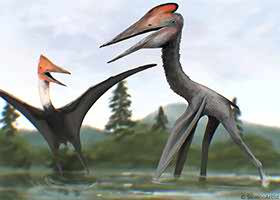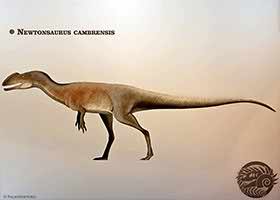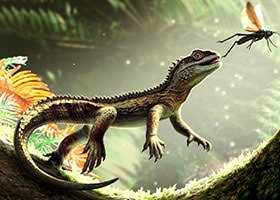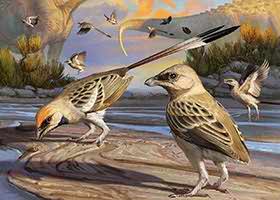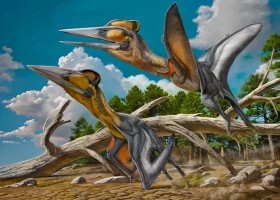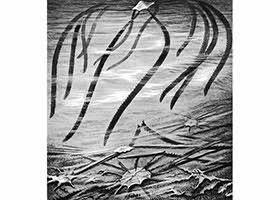
Tetrapodomorphs are early fish-like forms of the evolutionary line leading to tetrapods. These creatures lived during the Devonian period. They exhibited features intermediate between fish and tetrapods, including fin-like limbs with bones capable of supporting weight and primitive air-breathing lungs. All this indicates an adaptation to sustaining itself in shallow water or on land. Tetrapodomorpha played a crucial role in the history of vertebrate evolution, marking a decisive step in the emergence of land animals.
Tetrapodomorpha. Ahlberg, 1991. The term “tetrapodomorph” means “four-limbed form”. Tetrapodomorpha is an evolutionary group of vertebrates that includes all tetrapods (four-limbed vertebrates) and their closest sarcopterygian fish relatives. Researchers typically apply the name of the almost equivalent clade Choanata to all tetrapodomorphs, except for the most basal ones.
The fish-like ancestors of all tetrapods originated on the coasts of ancient China. The oldest fossils of the most basal tetrapodomorphs are known from the southwestern Chinese province of Yunnan, starting from the Early Devonian: Pragian (409 million years ago)—Tungsenia paradoxa and Emsian (395 million years ago)—Kenichthys campbelli.
The distribution of Tetrapodomorpha and the environment

Hypothesis about the routes of dispersal of tetrapodomorphs in Gondwana. Dashed lines show the movement of ancestral species, and question marks indicate a sparse fossil record. Devonian map ©2016 Colorado Plateau Geosystems Inc.
Then, their descendants from China spread westward across the southern continent of Gondwana. A group of these descendants reached the south of Euramerica before adapting to life on land. Devonian tetrapodomorphs achieved a cosmopolitan distribution and inhabited the tropics and subtropics of Laurasia and Gondwana. However, the Red Hill site in Pennsylvania, where tetrapodomorphs also lived, represents a river basin with a temperate climate.
They inhabited a startlingly wide range of environments. Predominantly, this was a freshwater environment. However, the discovery of such creatures as Ventastega and Tulerpeton in deposits representing conditions of varying salinity has called this view into question. In addition, the freshwater paleoecological interpretation of many other localities has recently been reinterpreted as estuarine, deltaic, or even coastal marine environments.
Origin of Tetrapodomorpha

Evolution of tetrapodomorphs, showing the most famous transitional fossils from being fully aquatic to those capable of walking on land: Eusthenopteron, Panderichthys, Tiktaalik, Acanthostega, Ichthyostega, and Pederpes.
The Tetrapodomorpha include an evolutionary line of extinct transitional fish-like forms, representing different stages of the development of four limbs from fins, and terrestrial vertebrates, the four-legged Tetrapoda. They originate from the clade Rhipidistia, which also includes their sister clade Dipnomorpha, consisting of Dipnoi (lungfishes) and the extinct Porolepiformes. Dipnomorpha and Tetrapodomorpha diverged in the early Devonian, 419—408 million years ago. The Tetrapodomorpha lineage consists of creatures with lobefins and creatures with limbs, all of which share a closer evolutionary relationship with living tetrapods than with living lungfishes.
The emergence of choanae and air breathing

Acanthostega. ©Raul Martin
Shallow, sun-warmed bodies of water, which constantly suffer from a lack of oxygen, forced the inhabitants of both groups to adapt to the assimilation of atmospheric oxygen. Such development in early forms of Tetrapodomorpha led to the appearance of internal nostrils and lungs. This adaptation facilitated the transition from aquatic to terrestrial environments.
The important characteristic of this process is the emergence of the internal nostril, or choana. Most fish have two pairs of nostrils, one for incoming water (incurrent nostrils) and another pair for outgoing water (excurrent nostrils). In such an early tetrapodomorph as Kenichthys, the external nostrils had already migrated to the edge of the mouth. In later tetrapodomorphs, including tetrapods, the outgoing nostril (excurrent nostril) already sits inside the mouth, known as the choana.
The choana is a key part of the respiratory system of terrestrial vertebrates. It was the first component of the body structure of tetrapods that evolved long before the appearance of limbs.
Lungfish were another group of sarcopterygians capable of breathing air. They also developed a choana, but its form differs from that of the Tetrapodomorpha.
Transformation of fins into limbs

Comparison of skeletal features of early tetrapods. (1) Eusthenopteron, (2) Panderichthys, (3) Acanthostega, (4) Ichthyostega (1-4 all Devonian), and (5) Balanerpeton (Carboniferous). ©2001 Blackwell Publishing (adapted from Coates M)
Shallow, often drying-up water bodies of variable configuration were densely overgrown with vegetation. The transformation of fins into limbs, apparently, occurred in order to move along the bottom of the water bodies and to push through dense thickets of algae and helophytes. Later, the already-emerged limbs proved to be particularly useful for moving to another neighboring water body or returning to coastal waters when finding oneself in a drying-up water body or being trapped during low tide in a temporary isolated puddle.
The first tetrapod-like creatures still had features such as gills (traces of gill slits remained in fossils) and a caudal fin. Informally, some call the more advanced forms transitional between fish and early labyrinthodonts “fishapods,” considering their half-fish, half-tetrapod appearance and limb morphology.
Scientists previously thought that the acquisition of a terrestrial lifestyle preceded the evolution of limbs with digits, caused by the need to adapt to existence on land—the “Drying Pond Scenario.” The osteolepid Eusthenopteron was thought to be able to support itself on land and make forays onto mudflats or sandbanks using its strong front fins. However, it turned out to be incorrect.

Illustration of Qikiqtania wakei (center) in the water with its larger cousin, Tiktaalik roseae. ©Alex Boersma
In fact, only a few of the adaptations of tetrapods are actually adaptations to life on land. Most of them are changes in structure aimed at a more efficient aquatic life. As a result, tetrapodomorphs acquired a set of aquatic specializations, which fortuitously proved useful for life on land.
Even Acanthostega, with its eight-digited limbs, tail with deep dorsal and ventral caudal fins, spine with repeating bone patterns, poorly ossified wrists, and primitively patterned lower arm bones, was clearly an aquatic animal. Ichthyostega also turned out to be much more aquatically adapted than for movement on solid ground. Even once on land, Devonian tetrapods could not make long movements there. Thus, the confirmation of the “limbs before terrestriality” scenario received serious affirmation and justification in contrast to the older view.
The beginning of digit development

Tetrapodomorpha limbs: (a) the forelimb of Eusthenopteron; (b) the forelimb of a recently discovered rhizodontid Sauripterus, probably showing convergent similarities with the tetrapod limb; and (c) the forelimb of Acanthostega. In all three limbs, the shading indicates the maximal potentially homologous regions using only the topological argument; the elements identified as homologous to metacarpals and phalanges in (a) and (b) might be homologous with distal carpals or have no homologies in stegocephalians. Anterior is to the left. Abbreviations: h – humerus; in—intermedium; r—radius; u—ulna; un—ulnare. ©Laurin at al.

Sauripteris pectoral fin.
Already in predatory rhizodonts, the forefins are massively complex, comparatively rigid, and equipped with powerful muscles. The fin rays (lepidotrichia) are unique in that they have a long, stiff basal area. The distal part of the fin of rhizodontids has segmented rays, which resemble the metacarpal bones and finger phalanges of autopodium. Most of them (six out of eight) articulate proximally with the wrist (ulna and intermediate bone). These eight rays can be considered homologous to the fingers of early stegocephalians (eight is also the maximum number of fingers found in stegocephalians). In the rhizodontid Sauripterus, the presumed phalanges and lepidotrichia are continuous with each other. This makes the forelimb of rhizodonts even closer to tetrapods than the paired fins of Panderichthys. These are not yet proto-fingers, but a step in the right direction. However, these similarities may be convergent.
Gradually, there was a reduction in dermal fin rays (modified scales that support the fins). This suggests that the structure, no longer necessary and possibly even hindering movement on land, was simply eliminated over time. For the same reason, the dorsal median and anal fins were gradually lost.
Initially, tetrapodomorphs had limbs with varying numbers of digits. Acanthostega had 8, Ichthyostega—7, and Tulerpeton—6 digits. The fact that these three oldest known autopods are polydactylous (and the fact that they belong to the three most basal taxa bearing digits) indicates that polydactyly is a primitive state of autopods. The number of digits reduced to five only in the Carboniferous, and pentadactyly apparently arose only once. Likewise, digits, like limbs, first appeared in an aquatic environment.
The modification of the humerus, skull, and other bones
Among the main characteristics defining the development of limbs in tetrapodomorphs, it is necessary to note such a modification of fins, as a result of which a humerus with a convex head developed, articulating with the glenoid fossa (the socket of the shoulder joint) of the scapulocoracoid.
In basal forms, the difference was still insignificant, because both surfaces relatively flat. But subsequently, the convex head of the humerus played a decisive role in the development of the forelimbs. Technically, placing a concave element experiencing a heavy load inside the body is preferable, as the immobile elements of the body stabilize it. If the head of the humerus were concave, the humerus would have to be much more massive to ensure the strength of the walls of the joint socket.
In fish, the humerus is short and has the shape of a block, which is an optimal adaptation for swimming. On the other hand, in terrestrial tetrapods, it is elongated, slightly twisted, and strong enough to withstand the weight of the animals and allow movement. In fossil forms from the transitional period between water and land, the humerus has an L-shaped form, which represents a compromise solution. Also, the humerus of the tetrapodomorph had deltoid and supinator processes.
As with all tetrapodomorphs, the largest component of the shoulder girdle in rhizodontids is the cleithrum. The humerus was already capable of a very wide range of movements.
None of the earliest tetrapods yet had a wrist capable of bending because they lacked a surface for the flexor muscle on the phalanges. Because of this, it was difficult for them to move across hard (rocky) surfaces. The lack of flexibility kept the tetrapodomorph closer to the soft, near-water soil, restraining their penetration deeper into the land.
The pelvic bones also changed in tetrapodomorphs, which are very small in other lobe-finned fish. Tiktaalik had pelvic bones comparable to those of the first tetrapods—Ichthyostega and Acanthostega. However, they had not yet connected to the vertebral column in the sacral region. Therefore, it could not fully rely on its hind fins. But the developed pelvis helped Tiktaalik crawl better on the bottom in shallow areas of water bodies.

A variety of transitional Tetrapodomorpha forms—from water to land. ©Masato Hattori
The skulls of tetrapodomorphs also demonstrate transitional features between fish and tetrapods. This includes changes in the structure of the jaws and the location of the sense organs. Their eyes shifted to the upper surface, which facilitated observation of the land. Breathing above water also required a number of changes in the skull and jaw. The parasymphysial tooth whorl is lost, and the vomers meet on the midline of the palate. The bones of the skull fused more tightly with each other, strengthening the snout. Further in the skeleton, a number of bones disappeared, which in fish connected the head with the shoulder girdle.
Tetrapodomorphs had characteristic piscivorous teeth. Most tetrapodomorph fishes (for example, the late Devonian active predator Eusthenopteron) and all early known tetrapods had teeth covered with enamel.
Features of tetrapodomorph movement

Harajicadectes zhumini. This is a tetrapodomorph, or tetrapod-like fish, from ancient rock deposits in central Australia. ©Brian Choo, Flinders University.
Early tetrapodomorphs inherited the S-shaped bending of the body during movement from their ancestors. The currently living Australian lungfish, Neoceratodus forsteri, provides the best example of the behavior and manner of locomotion of tetrapodomorph fish. On the other hand, the underwater walking along the bottom by the modern African lungfish Protopterus annectens can be used as an example of the mode of locomotion in stem tetrapods. However, it certainly cannot support its weight on its fins. Surprisingly, the most suitable examples come not from the tetrapodomorph clade itself but from their sister group, Dipnomorpha, whose representatives have preserved these primitive modes of locomotion to our time.
The fossil record and the ontogeny of limb development in fish and basal tetrapods demonstrate the early development of the forelimbs and the later development of the hind limbs, which became noticeable during the water-land transition. This led to the emergence of another hypothesis about the modes of locomotion of tetrapodomorphs:
The front and hind limbs of tetrapodomorphs had to perform different functional roles when moving across the substrate. The forelimbs could not extend far enough forward to provide alternating limb movements. The forelimbs likely functioned synchronously. They could serve as support to lift the front part of the body above the ground. Researchers assume this for tetrapodomorph fish such as Tiktaalik, as well as for the more advanced Ichthyostega. Their movement could partially resemble the terrestrial locomotion of mudskippers (Periopthalmus). However, an important distinction is that in mudskippers, the ventral fins are at the front, almost on the same level as the pelvic ones, while stem tetrapods have hind limbs placed posteriorly. (Pierce et al., 2013).
Composition of the Tetrapodomorpha clade

Tetrapodomorphs belong to the clade Rhipidistia, which in turn is part of the clade Sarcopterygii. Tetrapodomorpha itself includes such clades:
Basal Tetrapodomorpha:
Various groups of stem tetrapodomorphs, sequentially closer to the crown group Tetrapoda:
Choanata:
Rhizodontida
Osteolepidida
Eotetrapodiformes:
Tristichopteridae
Elpistostegalia (Panderichthyida):
Stegocephali (Tetrapoda sensu lato)












